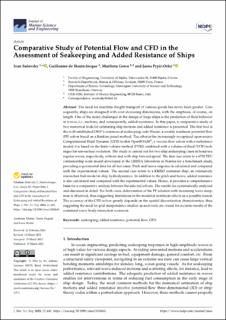| dc.description.abstract | The need for maritime freight transport of various goods has never been greater. Consequently, ships are designed with ever-increasing dimensions, with the emphasis, of course, on length. One of the many challenges in the design of large ships is the prediction of their behavior in waves, i.e., motions, and consequently, added resistance. In this paper, a comparative study of two numerical tools for estimating ship motions and added resistance is presented. The first tool is the well-established DNV’s commercial seakeeping code Wasim, a weakly nonlinear potential flow (PF) solver based on a Rankine panel method. The other is the increasingly recognized open-source Computational Fluid Dynamic (CFD) toolkit OpenFOAM®, a viscous flow solver with a turbulence model; it is based on the finite volume method (FVM) combined with a volume-of-fluid (VOF) technique for sea-surface evolution. The study is carried out for two ship seakeeping cases in head-sea regular waves, respectively, without and with ship forward speed. The first case refers to a 6750 TEU containership scale model developed at the LHEEA laboratory in Nantes for a benchmark study, providing experimental data for all test cases. Pitch and heave response is calculated and compared with the experimental values. The second case refers to a KRISO container ship, an extensively researched hull model in ship hydrodynamics. In addition to the pitch and heave, added resistance is also calculated and compared with the experimental values. Hence, it provides a comprehensive basis for a comparative analysis between the selected solvers. The results are systematically analyzed and discussed in detail. For both cases, deterioration of the PF solution with increasing wave steepness is observed, thus suggesting limitations in the modeled nonlinear effects as a possible reason. The accuracy of the CFD solver greatly depends on the spatial discretization characteristics, thus suggesting the need for grid independence studies, as such tools are crucial for accurate results of the examined wave–body interaction scenarios. | en_US |

